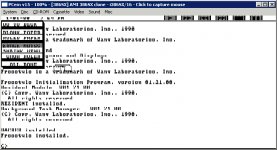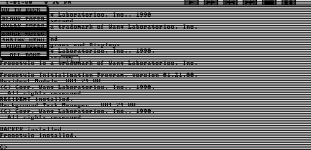SomeGuy
Veteran Member
I've been trying to get some screen shots of a program called Freestyle, ironically it is sort of a screen shot/annotator program but it can't take screen shots of itself. This has turned in to more of a puzzle than I expected.
It seems that this program, when used on VGA, attempts to run in 720x348 monochrome similar to Hercules Monographics. But that is not a documented mode for any VGA card.
It is very hit or miss if it works on a particular VGA card. Some just can't/won't do it. A few actually work. I'm guessing that it is doing something very wonky underneath the hood. I tried PCXDUMP on a compatible card, and it just gives me a garbled image.
Here is what I have tried so far:
Works - MCT-VGA-16 "Paradise" TD3588A ISA card, and NVIDIA Vanta AGP card
Sort of works and graphics are drawn, but text is corrupted - Video 7 VGA 1024i
Blocky "doubled" screen (half appears on the top and half appears on the bottom) - NVIDIA GeForce 8400GS
Scan lines doubled but in wrong place? - PCem set to just VGA
Half of the scan lines are drawn as black - PCem other VGA cards
Black screen - Lenovo with some integrated crap
I'd sort of assume this would work on genuine IBM VGA and PS/2s.
Here is what it looks like on my CRT with a card that works:

Here is what PCem set to IBM VGA does:

Also, PCem set to other video does:

Ideally, if I could just get this working in an emulator, but if this is something that really shouldn't work...
Of course, WTF is it doing trying to emulate Herc? Why not just use 640*480 or similar? No wonder this program flopped.
It was actually designed to run on a custom high-resolution card, the Wang 9229, with a high resolution monitor. I think the resolution was supposed to be 1024*something, and meant for desktop publishing. (Anyone want to try emulating that? )
)
It seems that this program, when used on VGA, attempts to run in 720x348 monochrome similar to Hercules Monographics. But that is not a documented mode for any VGA card.
It is very hit or miss if it works on a particular VGA card. Some just can't/won't do it. A few actually work. I'm guessing that it is doing something very wonky underneath the hood. I tried PCXDUMP on a compatible card, and it just gives me a garbled image.
Here is what I have tried so far:
Works - MCT-VGA-16 "Paradise" TD3588A ISA card, and NVIDIA Vanta AGP card
Sort of works and graphics are drawn, but text is corrupted - Video 7 VGA 1024i
Blocky "doubled" screen (half appears on the top and half appears on the bottom) - NVIDIA GeForce 8400GS
Scan lines doubled but in wrong place? - PCem set to just VGA
Half of the scan lines are drawn as black - PCem other VGA cards
Black screen - Lenovo with some integrated crap
I'd sort of assume this would work on genuine IBM VGA and PS/2s.
Here is what it looks like on my CRT with a card that works:

Here is what PCem set to IBM VGA does:

Also, PCem set to other video does:

Ideally, if I could just get this working in an emulator, but if this is something that really shouldn't work...
Of course, WTF is it doing trying to emulate Herc? Why not just use 640*480 or similar? No wonder this program flopped.
It was actually designed to run on a custom high-resolution card, the Wang 9229, with a high resolution monitor. I think the resolution was supposed to be 1024*something, and meant for desktop publishing. (Anyone want to try emulating that?
